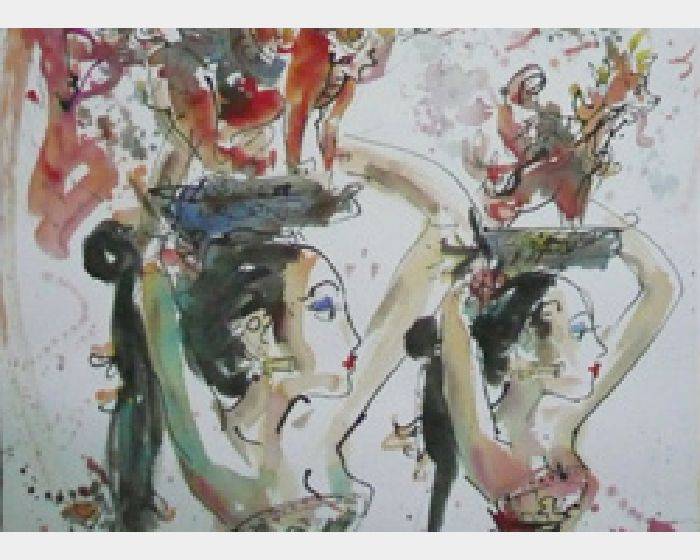
Nyoman Gunarsa is one of Indonesia’s most active promoters of Balinese art and a guiding voice for greater attention to the nation’s museums. Born in Klungkung, East Bali on April 15, 1944, Gunarsa received his formal art training at the Academy of Indonesian Fine Arts (ASRI) in Yogyakarta, Central Java.
His paintings invariably flow from the stories of the daily life of the Balinese people and the legendary Hindu Dharma epics. Distinctive in their free flowing quality and frequent incorporation of wayang (shadow puppet) themes, his paintings are found in the collections of leading museums and leading private collectors worldwide.
Spontaneous, lyrical and jocular describe both the man and his art. His subjects can be drawn from traditional dance, Balinese music, religious ritual or the natural environment.
After graduating from ASRI, the Balinese artist initially worked as an instructor at his alma mater. In the change of decades that ushered in the artistically tumultuous and politically challenging Indonesia of the 1960s, Gunarsa journey began from a starting point in artistic realism before discovering his true milieu as an expressionist.
His early expressionist period was heavily influenced by the Wayang Kulit (shadow puppet) characters. The mythical stories learned while growing up in a Balinese village launched an instinctual approach to paiting that could see an entire canvas filled to artistic perfection in little more than an hour. Arms flailing before a canvas, Gunarsa was likened by some to a musical conductor, earning him the "Maestro" monicker that has stuck to this day. Bold strokes delivered with astounding fluidity results in works that somehow manage to blend Bali’s ancient Abu Aringgit traditions with a form that remains unfailingly contemporary.
“I paint lines like I sing; I apply colors like I dance,” explains Gunarsa.
Working in both oil and water colors, to watch Nyoman Gunarsa is indeed akin to watching a "maestro" or, perhaps, an accomplished Balinese dancer perform. The canvas is his stage and his strokes dance movements. His paintings epitomize absolute freedom of subject, theme, color and stroke.
Gunarsa says, “Through my swipes of color and my unordered lines the basic element of my work, which is rhythm, is revealed.”
In the 1970s Nyoman Gunarsa established, together with a number of Balinese artists working in Central Java, the Sangar Dewata Indonesia in Yogyakarta. The Sanggar's membersip included the likes of Gunarsa, Made Wiantar, Pande Supada and Wayan Sikka. Caught between conflicting modernist and realist waves then sweeping through the Indonesian art community, the Balinese artists gathered together in the Sanggar Dewata Indonesia worked to create their own artistic tradition that incorporated Balinese symbols and themes.
Later, in 1989, Gunarsa established the Museum Seni Lukis Kontemporer Indonesia Nyoman Gunarsa (The Nyoman Gunarsa Museum of Contemporary Art) in Yogyakarta. This was followed by the opening of the Museum Seni Lukis Klasik Bali (Bali Museum of Classical Painting) in Klungkung, Bali in 1990.
Both Gunarsa’s life and his art underwent a transformation in 1998 when he suffered a serious stroke. Now largely recovered, he describes this period as “Moksa” – a Sanskrit term which means “release” from the reoccurring cycle of pain and death embodied in earth-bound reincarnation. Liberated and enlightened by his close brush with mortality, Gunarsa now feels himself completely free and at one with the cosmos.
The "transformed" Gunarsa's artistic expression hovers between reality and non-reality; between dream and flight. The more than 100 paintings created since Gunarsa’s illness portray a man at home with his place in the universe painting happily against the beauty of nature provided by his Klungkung, East Bali home.

